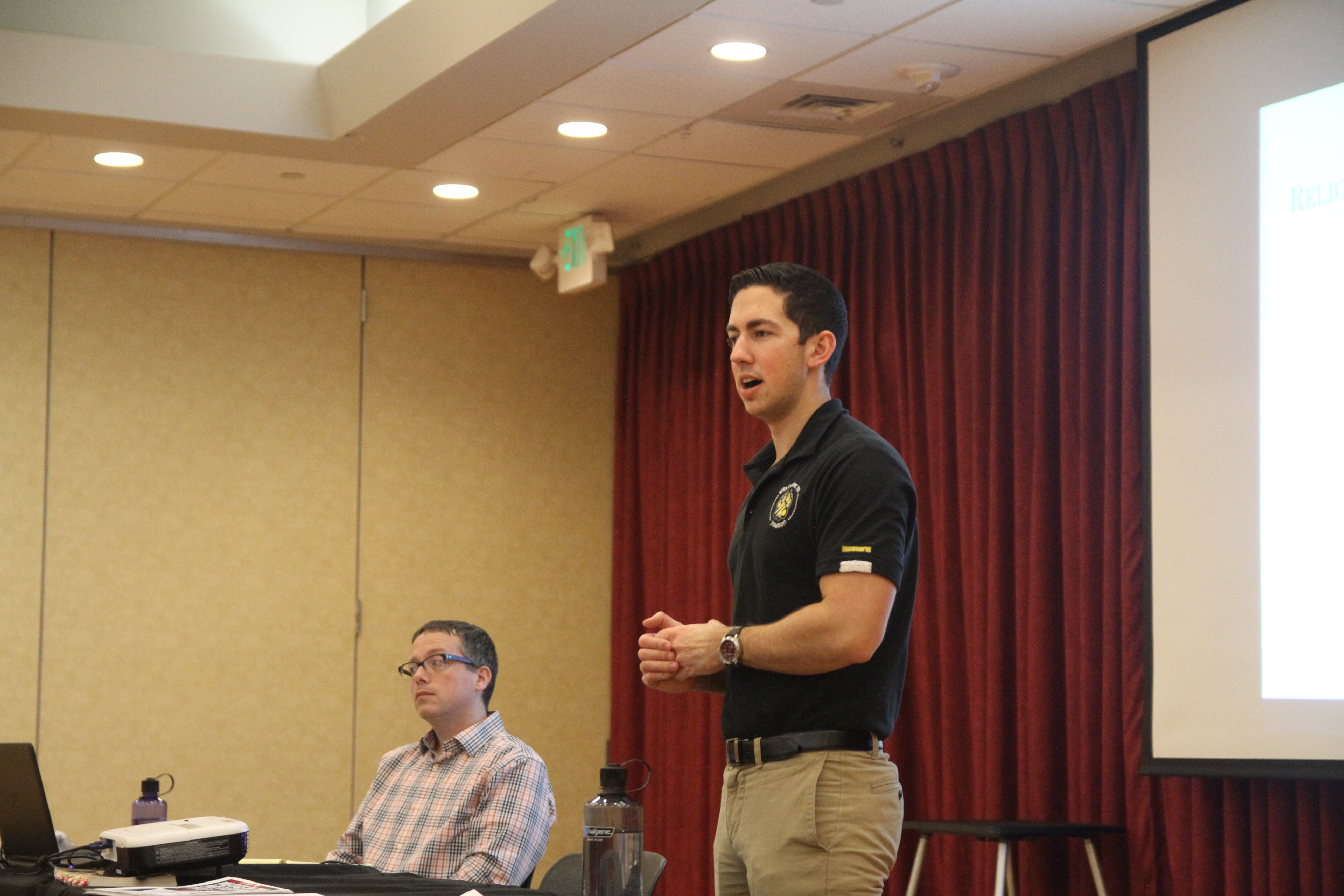
Religion and politics are linked, professor says
By: Marcus Dieterle, Assistant News Editor
Despite growing religious diversification in the United States, data show that the country’s religious and political planes remain tilted in favor of white Christians.
In a campus conversation about religion and politics in the U.S. on March 9, Towson University political science professor John McTague presented data demonstrating how changes within religious groups, political parties and age groups have affected political participation.
“Religion has always been a central concern in American politics,” McTague said.
According to the Pew Research Center, the Christian portion of the U.S. fell 7.8 percent — from 78.4 percent in 2007 to 70.6 percent in 2014 — but remained the dominant religion.
In contrast, the unaffiliated population grew 6.7 percent from 16.1 percent in 2007 to 22.8 percent in 2014. Non-Christian faiths – including Jews, Muslims, Buddhists, Hindus and other world religions and faiths – grew 1.2 percent from 4.7 percent in 2007 to 5.9 percent in 2014.
“Eventually the country is going to get less Christian and less white,” McTague said.
According to the PRC, in 2014, 63 percent of Democrats identified as Christian, 8 percent as non-Christian faiths and 28 percent as unaffiliated. 82 percent of Republicans identified as Christian, 3 percent as non-Christian and 14 percent as unaffiliated.
The PRC also analyzed exit poll data from the 2000, 2004, 2008, 2012 and 2016 general elections.
The data showed that in the 2016 election, a majority of Protestants/other Christians, white born-again/evangelical Christians, and Mormons voted for Donald Trump. A majority of Jews, other faiths and the religiously unaffiliated voted for Hillary Clinton.
While most Catholics voted for Trump, the subdivisions of White Catholics and Hispanic Catholics were almost complete opposites of one another: 60 percent of White Catholics voted for Trump, whereas 67 percent of Hispanics voted for Clinton.
Acceptance of politicians’ personal indiscretions grew among almost all Americans surveyed in a study by the Professional Relations and Research Institute (PRRI), except for unaffiliated voters whose acceptance of indiscretions decreased marginally.
White evangelical Protestants experienced the largest growth in this category, with 30 percent in 2001 rising to 72 percent in 2016. McTague attributed this to white Evangelical voters’ need to justify their vote for Trump to get an anti-abortion rights justice appointed to the Supreme Court.
“The Supreme Court is very important to them because the abortion issue is important to them,” he said.
Excluding white Evangelical Protestants and Mormons, the majority of each religious group opposed allowing small business owners to refuse providing products or services to gay or lesbian people if doing so violated the owner’s religious beliefs.
“There is a conflict between people who wish to exercise their religious freedom and people who wish to exist somewhere within the LGBT community,” McTague said.
In a 2016 American National Election Study Pilot which ranked average feelings toward social groups on a 0-100 scale, Muslims received a 45 – the only group to receive less than a 50.
A December 2015 survey by PRRI and Religion News Service found a double standard when it comes to religious violence. Respondents were asked whether a person who claims to be a certain religion and who commits violence in the name of that religion is in fact a member of that religion.
When the hypothetical situation involved a person committing violence in the name of Christianity, 19 percent of respondents answered that the person was Christian. When the hypothetical person was committing violence in the name of Islam, 37 percent of respondents answered that the person was Muslim.
After McTague’s presentation, students divided into small groups to discuss a series of questions about the relationship between religion and politics. Group members discussed their own religious affiliations and interactions they have had with people from different religious backgrounds. They also talked about some of the data points highlighted in McTague’s presentation, such as decreasing religious identification among millennials and the relevance of the white Christian demographic decline.
The attendees then rejoined the larger group to discuss the conversations that they had in their small groups. The larger discussion focused on anti-Semitism and white supremacy which quickly devolved into partisan debate.
In an effort to refocus the discussion, political science major Matt Pipkin disavowed hate regardless of which side of the political spectrum it was coming from.
“It’s not fair to characterize either side of the spectrum based on the actions of a small group,” Pipkin said.
The event was sponsored by the Office of Civic Engagement and Leadership. The next event will be a New York Times Talk about fake news on March 15.

